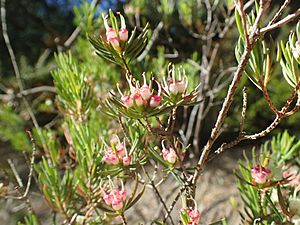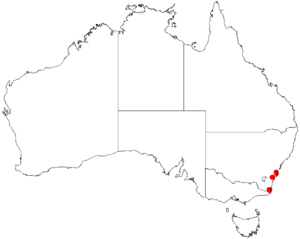Darwinia briggsiae facts for kids
Quick facts for kids Darwinia briggsiae |
|
|---|---|
 |
|
| Darwinia briggsiae in the ANBG | |
| Scientific classification | |
| Genus: |
Darwinia
|
| Species: |
briggsiae
|
 |
|
| Occurrence data from AVH | |
Darwinia briggsiae is a special plant from the myrtle family that only grows in New South Wales, Australia. It's a type of shrub that stands upright and has long, thin leaves. You can spot its pretty pink and white flowers growing in small groups.
What Does It Look Like?
Darwinia briggsiae is an upright shrub, meaning it grows straight up. It can reach about 1.5 meters (5 feet) tall.
Its leaves are smooth and hairless (that's what 'glabrous' means!). They are long and thin, like tiny lines, usually 11-18 mm (about half an inch) long and only 1 mm wide. The top surface of the leaf is slightly curved inwards, like a shallow dish.
The flowers grow in small bunches, with up to six flowers in each group. Each flower has a very short stalk (0.5-1 mm long) and grows where a leaf meets the stem (this spot is called a leaf axil). The base of the flower forms a cup-like shape, about 5 mm long and 1-2 mm wide. This 'floral cup' has five small ridges.
The sepals, which are like small leaves protecting the flower bud, are triangular and about 0.5 mm long. The petals are 1-1.5 mm long and have a small notch at their top end. A long, thin part of the flower called the style sticks out from the flower tube, measuring about 7-8 mm. This plant usually blooms from September to March.
How It Got Its Name
Darwinia briggsiae was first officially described in 1991. The scientists who described it were Lyndley Craven and S.R.Jones. They published their findings in a science journal called Australian Systematic Botany.
The second part of its name, briggsiae, was chosen to honor an Australian botanist named Barbara G. Briggs.
Where Does It Grow?
This type of darwinia plant likes to grow in areas with heathland plants and also in thickets of she-oak trees. You can find it in the Budawang Range and at Macquarie Pass in New South Wales.

